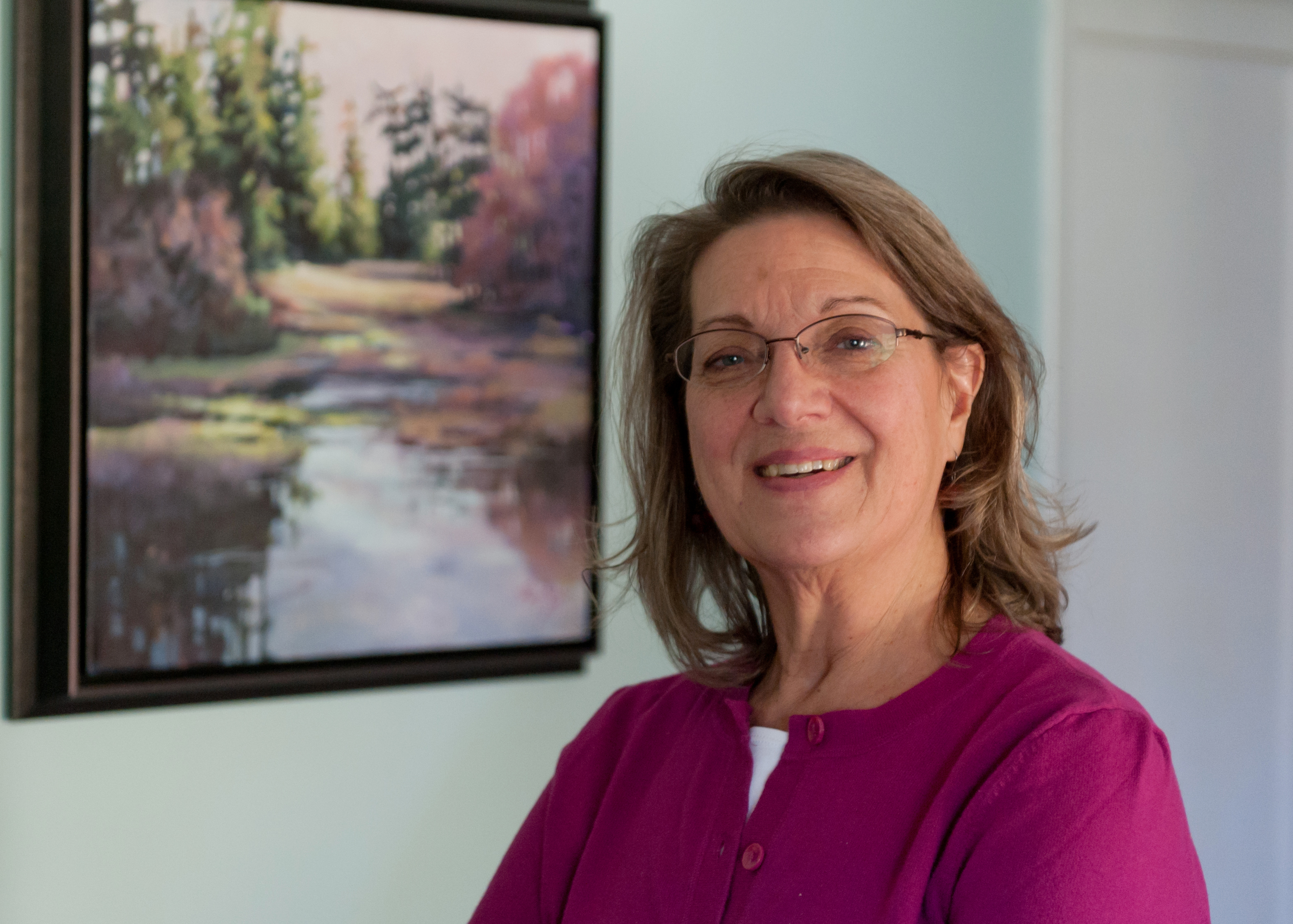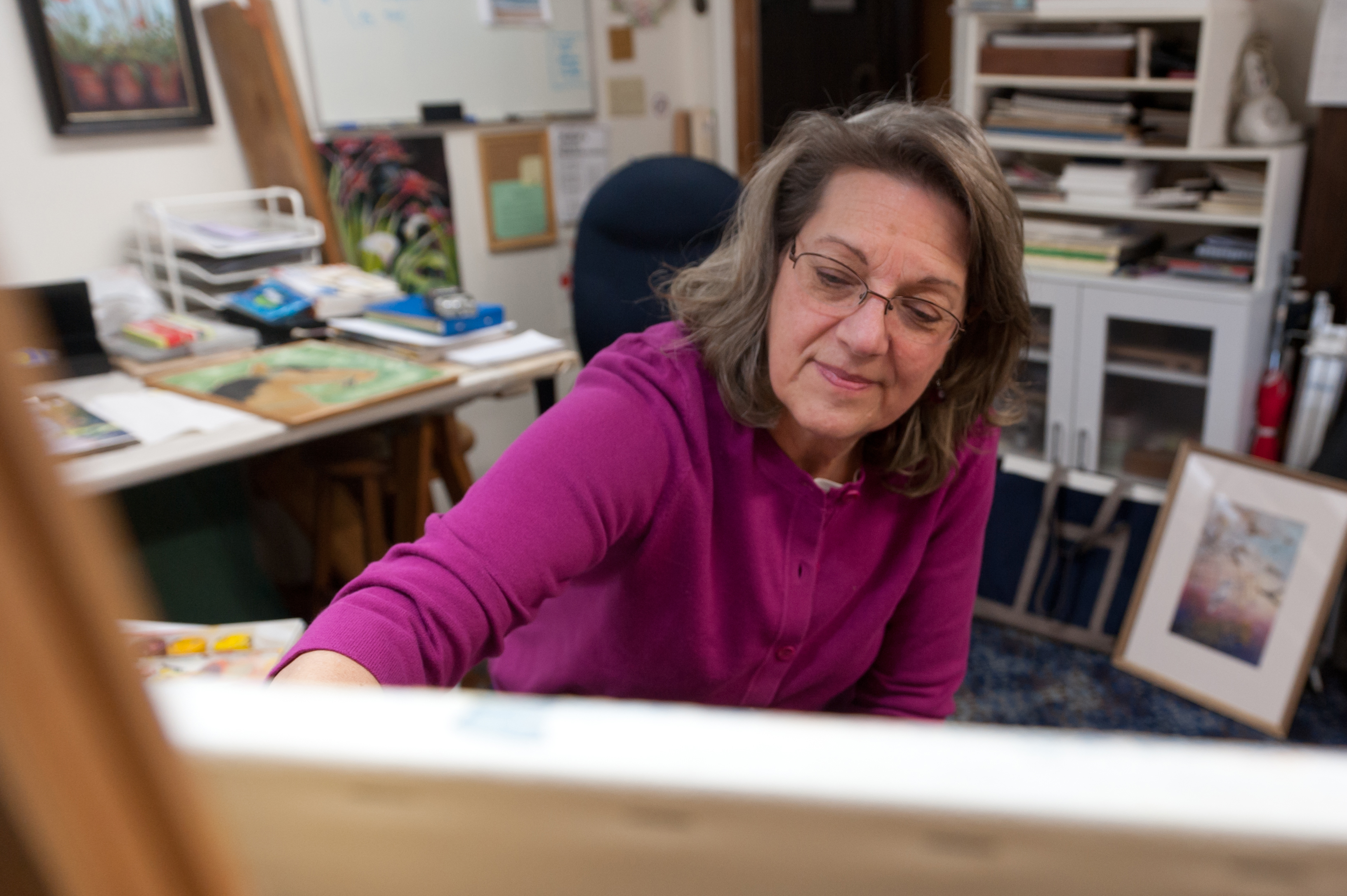Many artists produce work designed to shock, provoke, challenge, titillate or cause viewers to question their values or perceptions. Jill Paris Rody just wants you to relax.
“Her art is tremendously atmospheric,” said Ken Blackburn, a fellow artist and head of Campbell River Art Gallery. “I find it emotional, almost dreamlike.”
Which is not to say Paris Rody lives sequestered away, living an ethereal existence while churning out colourful canvases. This is a woman with a very real presence in the community.
For every hour she spends creating her own paintings, Paris Rody devotes essentially the same time to teaching a variety of art classes, working with head injury patients in their recovery, volunteering on the board of the Campbell River Arts Council and sharing her time for projects like the recently unveiled Art in the Hospital initiative.
At an age when most people are entering into retirement, she has also for the first time secured an agent, in the form of longtime friend Ruth McMonagle.
“As far as my art goes, this is the busiest time in my life,” said Paris Rody, now 65. “There’s always something to do.”
It’s not that Paris Rody lived a life of leisure prior to kick-starting her current art career. She grew up in Lake Oswego, Oregon, where she discovered her passion for art at an early age. After attending Oregon State University for a year and finishing her post-secondary education at Portland Community College, she met Mike Rody, a young Canadian Forces member vacationing stateside.
She followed him back to Comox where they were married. Two years later, they moved into the Oyster River-area home where they remain to this day. She initially worked for a small, home-based newspaper in Comox, but also taught an oil-painting class out of the family’s kitchen in Courtenay.
“I think I charged a dollar an hour,” she said.
Following the move to the Campbell River side of Oyster River, Paris Rody spent four months doing paste-up for the Campbell River Mirror, and spent another seven months working at Irly’s Building Supply in Black Creek — “because my husband thought it was a great idea for me to work in a hardware store,” she said with a laugh. “Then we had our first baby, and I became a stay-at-home mom for 16 years.”
During that time, however, Paris-Rody leaned on her artistic background to take the first steps toward establishing a career in art. It began simply by volunteering with the Parent Auxiliary Council at Oyster River Elementary School, in a very specific capacity.
“I headed up the parent auxiliary crafts section,” she said. “I wasn’t president; it was more being involved in craft fairs and fund-raising for activities with crafts involved, because that’s my area of expertise.”
When the couple’s youngest child reached age 12, in the early 1990s, Paris Rody became heavily involved in the burgeoning craft of decorative art. She spent 12 years involved in an international organization devoted to decorative art, both creating designs, teaching classes in their application and publishing a how-to book with instructions and patterns, in 2002.
The woman who had spent nearly her entire life living in just two homes was now traveling internationally attending and teaching at conferences.
“I was using my fine arts background as the basis for design and teaching,” she said. “That was a wonderful experience for me.”
In time, it provided the catalyst for her return to fine arts. She had been teaching decorative art classes at Calico and Cross Stitch, a Campbell River crafts store. When it was purchased by Jurgen and Inge Cutler and renamed Needle and Art Centre, Paris Rody stayed on and expanded her teaching to fine arts while helping the business develop its line of supplies.
“I was in that building through three different owners over 13 years,” she said. “They all kept me on, because I was bringing in new customers.”
What began as a “Paint your Pet” class eventually became open studio instruction, which she moved to her own basement studio for a period of seven years.
“I never thought about teaching when I was in school,” Paris Rody said. “But I was always interested in people; psychology was always one of my favourite courses in high school.
“I’ve always looked at my teaching as a form of sharing. And rather than teaching from head knowledge, a lot of heart goes into it, too. I work really hard to try to understand what my students need. And I guess that’s part of the joy and excitement of being a teacher, is having that victory of reaching them, and sharing.”
She now teaches classes twice a week at the Sybil Andrews Cottage, and last year became involved in helping instruct at the head injury centre for victims of stroke and traumatic injuries — people who are literally teaching their brains how to work again.
“That can be very challenging work, but she doesn’t see it as if she’s giving to this group,” Blackburn said. “She sees it as a great opportunity to learn from these people who have great challenges, but also great stories. I think the thing that stands out most for us at the arts council is that she’s very passionate for the community.”
Paris Rody brings that passion to her own work, which she performs in that basement studio that has gone from classroom to strictly working studio. She will occasionally paint animals, introspective abstract works and flowers — “I love poppies; I think that’s the only flower I’ve painted because it’s the one plant I grow that I really like. Maybe if I had a bigger garden with more variety …” — but landscapes featuring trees are her calling card.
These scenes depict real places, but in an almost soft-focus style emphasizing colour and textured brush strokes.
“I’ve been in places Jill has painted, and they’re quite accurate,” said Blackburn. “But she doesn’t depict the scene as it appears, rather she depicts it as an emotional response. It’s kind of how we remember things, or how it is in our dreams.”
 Paris Rody also eschews broad, sweeping panoramas in favour of intimate settings. Rather than a wide beach with a sweeping surf, she may focus on a tree suspended on a cliff above a small cove. Instead of the grandeur of Vancouver Island’s spinal mountains, she’ll paint a small section of a slough, with the hazy suggestion of a small bird or other creature creating a ripple that provides the only motion in the quiet still-life.
Paris Rody also eschews broad, sweeping panoramas in favour of intimate settings. Rather than a wide beach with a sweeping surf, she may focus on a tree suspended on a cliff above a small cove. Instead of the grandeur of Vancouver Island’s spinal mountains, she’ll paint a small section of a slough, with the hazy suggestion of a small bird or other creature creating a ripple that provides the only motion in the quiet still-life.
“I tend to see a story in these smaller, intimate scenes,” Paris Rody said. “I guess what I try to express in my art is a type of peace and tranquility. That’s important to me, because we have a lot of commotion in our lives.”
Most of the excitement in her art comes through her use of colour, often applied in generous, textured brush strokes. It has been a trademark from the time of Paris Rody’s first oil painting, a picture of the family’s horse she painted as a 13-year-old and still owns. Upon seeing the finished painting, her mother pointed out young Jill had forgotten to include the background. So she returned to layer the canvas with broad, sweeping green strokes extending outward from the horse’s head.
“I was thinking of grass, so I just did green rays of light going around the horse,” she said with a laugh.
Already intrigued by various arts and crafts projects as a young schoolgirl, Paris Rody got into oil painting after her mother acquired supplies while hoping to take her own course.
“My dad, bless his heart, couldn’t live with the oils,” Paris Rody said. “I wish my dad were here now to hear this, but mom would say, ‘Well, dad doesn’t like me to use the oils, but if you’re using them maybe he won’t object too much.'”
Paris Rody said her father instilled his own love of nature, as a land surveyor, mapmaker and landscape artist, to her upbringing. He taught her the difference between trees and different kinds of plants, and she says the ability to paint is all based upon how the artist sees the subject.
“It’s not just ‘the red flower’, but how many petals does it have? And how big is this petal compared to that petal? Some people look at a tree and see green. Well, I see 12 or 15 different values and colours of green every time I look out the window.”
And now, it may be time for the rest of the country to sit up and take notice. Ruth McMonagle has sold many of Paris Rody’s painting from Stillwater Books and Art, a business she and her husband formerly operated from a storefront before moving it into their home and online.
Now, she’s hoping to share the artist’s story across Canada, along with local clients like Blackburn and Heather Hughson.
“Primarily, her skill level is very high, particularly her capacity to work with and adjust colour,” McMonagle said of Paris Rody. “From the emotional side, what people feel is what most draws them in. And, whether it’s nostalgia of her childhood, or her trees, people get a sense of serenity; they identify with her enjoyment of the essence of nature. “Others are discordant, powerful. She’s not that sort of artist. She draws you into the picture, and most people find serenity, peacefulness.”
As a child, experiencing a love of art and a love of horses, Paris Rody remembers envisioning her future.
“My first thoughts were, I was either going to marry a rancher and raise horses, or I was going to be a professional artist,” she said.
In which case, Paris Rody is an artistic workhorse living a dream.
